Desert Waterfalls
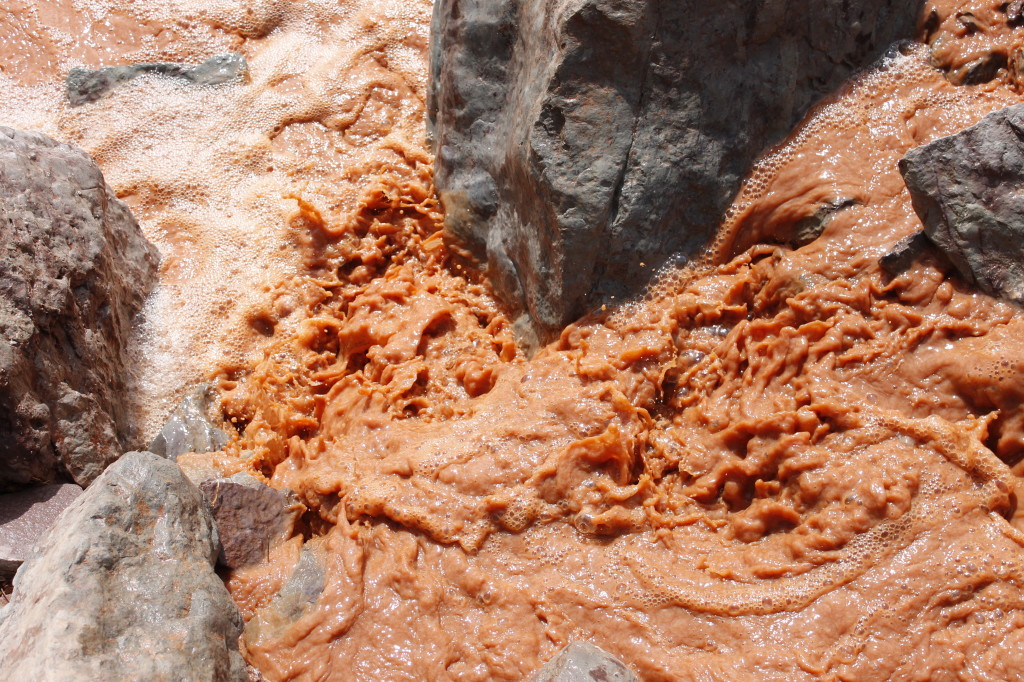
The river churning down through Courthouse Wash ran Yoo-hoo brown beneath the bridge where the main road crossed over. Over a night of rain, what had been a trickle of water, wending its way through canyon and under mesa, had swelled into a dirty monster of fast-flowing current in the middle of Arches National Park — large enough to kayak to the Colorado River. That was exactly what a trio of Canadians who showed up at the crossing with a trailer and three whitewater boats had in mind.
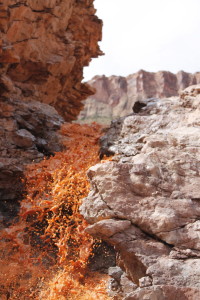
This would be the first chance for someone to do the Wash in 20 years, one of them declared. Though this was probably an overstatement, it still made me look longingly at the lone yak in our group of three. It had come with Andrew and his brother Jon. We planned on paddling on this trip; the yak was just luggage, on top of Andrew’s Subaru, headed to Jensen, UT where the two are raft guiding this summer. One of us would get the chance to go down, or else none of us would.
The Canadians had brought their yaks intending to paddle them, but in the big water around Moab. Courthouse Wash would be an unexpected treat. They expected Class III rapids, with a Class IV ledge or two.
We eventually turned down their offer, opting to stick together, and stick to the original plan to use our backcountry permit to explore the Fiery Furnace. The Furnace is a sprawling maze of rock formations in Arches, which Andrew and I explored last year. That had been on a hot sunny day. Now it was overcast, with dark clouds and bands of rain coming at us from the south. Occasionally, there came a peal of thunder.
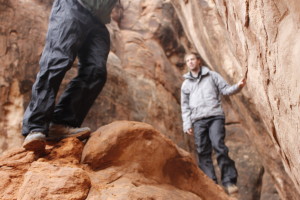
It’s hard to have much more than a rough idea of what part of the Furnace you are in at a given time. We scurried between some narrow passages in the rock, hoping to find a spot where we could chimney up to a higher passage. There was one narrow spot that Andrew and I tried climbing, but it came to a dead end. It began to rain. I stuffed my camera underneath my rain jacket as Jon, Andrew and I walked back the way we came along the washes at the bottom of the canyons. Water poured in gouts off the rock faces. Within minutes, the canyon bottoms were running with several inches of brownish water.
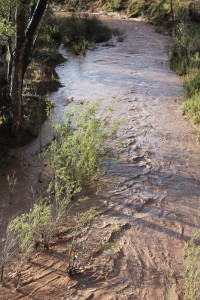
We tramped through the freezing current headed south. Sometimes there was a place where we could step out; more often we just had to slosh our way along. The water became knee-deep, and in a couple of places one of us would plunge in to the waist. There was a confluence in the streams that offered passage to the north and east, an area we had yet to explore.
We sloshed along for another quarter-mile, then found ourselves looking at the stream pouring off a 10-foot escarpment — right underneath an arch. Beyond it, a 20-foot waterfall, gushed over a ledge into a boiling pool.
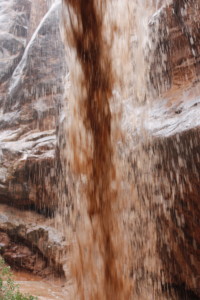
I went to take a picture, found that I’d fogged the camera and cursed myself. We found a path to the left of the arch and went up to the bigger cascade, which had an alcove behind it where we could step behind the falling water. We thought about other hikers we’d seen earlier who’d turned back because they hadn’t wanted to do the Furnace in the rain. For a minute, it was worth the shivering and gritted teeth.
Later we found a passage up a canyon that took us to higher ground and a tough chimney climb in between two walls. That effort eventually rewarded us with a misty view of the rock formations. The towers of the furnace looked a bit like mushrooms to me. Each pillar of soft sandstone wore a cap of tougher rock, which prevented it from eroding like the vanished material which it had once been a part of. Now, they towered over a hundred feet above the washed out desert floor. There came a sound of cracking followed by a tumble reverberating through the Furnace like thunder.
“Holy shit!” I heard Andrew exclaim.
I was around a corner and missed what happened. One of the pillars had a dry-patch at the top, like something had just broken off. Below, lay a couple thousand pounds of shattered rock. The lucky bastard had seen it all, literally, go down. Of course, all of us were lucky that we were nowhere near it when it had happened. It would be foolish to equate the size and scale of the Furnace’s towers with permanence. Indeed, the same wear that gave them shape will eventually destroy them, creating new forms as it flows through the landscape. It was interesting to think that the shape of the canyons would dictate where the water ran, but course of the water also dictates the shape of the canyon. The stone monuments and the runoff were like two voices in the same harmony. The sediment-brown waters held destruction and creation equally within their flow.
Check this out. It looks like our kayaking friends posted a video of their run. This was not for the faint of heart. https://www.youtube.com/watch?v=bWBOjxJ1Jdg
